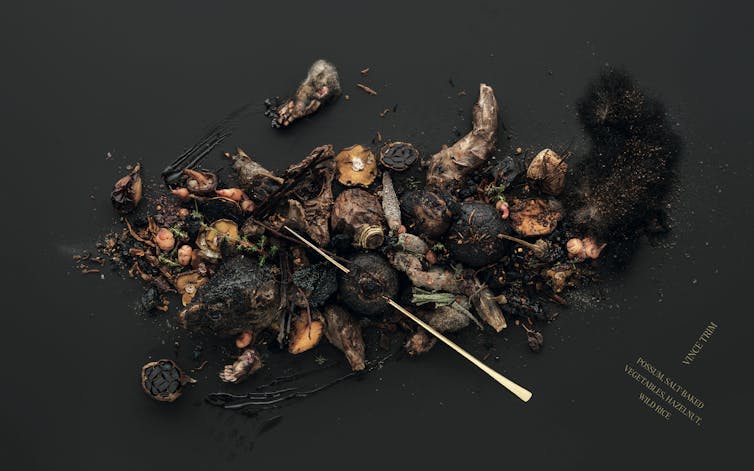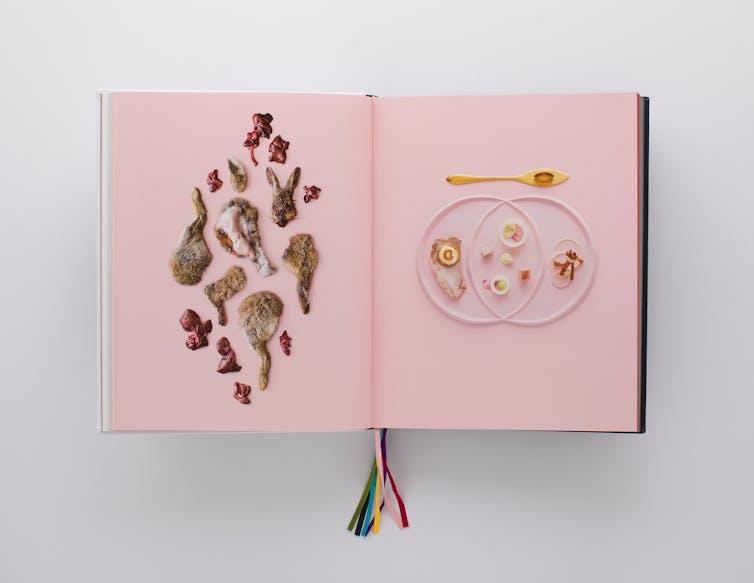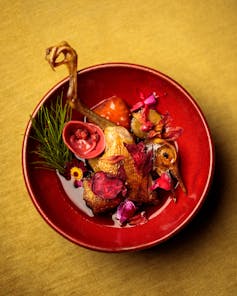MONA's Eat the Problem is possibly well-meaning but ultimately exquisitely elitist
- Written by Svenja J. Kratz, Lecturer in Interdisciplinary Creative Practice, University of Tasmania
Eat the Problem, Kirsha Kaechele’s latest MONA-based project, proposes that killing and consuming invasive species offers a more sustainable and ethical option than our current industrial farming practices.
In some ways, Kaechele’s work is a welcome contribution to a complex topic. We do need to imagine strategies to combat current and anticipated ecological crises. Art and playful speculations are valuable ways of inviting people to consider alternatives.
Still, while this premise offers a good starting point for critical discussion, the outcome comes across, in my view, as little more than an exquisitely designed elitist spectacle. It fails to take into consideration the complex realities this proposition entails and does not seem to recognise how the design and curatorial decisions draw attention to - but don’t challenge - the growing disparity between the rich and the poor.
As indicated on Kirsha’s Portal on the MONA website, Eat the Problem encompasses a book, exhibition, treatments and feasts. The book (a 544-page, hardcover volume) features essays, literary and visual works alongside provocative invasive species recipes with ingredients such as blackberries, cane toad, starfish, rabbit, horse, deer and camel.
There is even a recipe for human. And humans, after all, (albeit a select group) are the most invasive and destructive species on the planet.
 Possum, salt-baked vegetables, hazelnut, wild rice by Vince Trim Recipe from Eat the Problem by Kirsha Kaechele, Mona.
Photo credit Rémi Chauvin Image courtesy Mona Museum of Old and New Art, Hobart, Tasmania, Australia
Possum, salt-baked vegetables, hazelnut, wild rice by Vince Trim Recipe from Eat the Problem by Kirsha Kaechele, Mona.
Photo credit Rémi Chauvin Image courtesy Mona Museum of Old and New Art, Hobart, Tasmania, Australia
There are authors from diverse cultural backgrounds, but the book noticeably capitalises on MONA’s intimate relationship with some of the world’s most recognisable artists and chefs. Contributors include culinary celebrities such as Heston Blumenthal, Tetsuya Wakuda and Shannon Bennett and superstars of the art and humanities worlds including James Turrell, Marina Abramović, Mike Parr and Germaine Greer.
While the impressive list of authors already guarantees readership interest, the publication itself is also absolutely beautiful. Organised into different color-coded sections graduating along the spectrum from white to black, each page is elegantly formatted.
Recipe pages are particularly stunning, with carefully crafted compositions that include bespoke plates and cutlery. At the entrance of the exhibition, I watched a museum visitor view a sample publication as an invigilator gracefully turned the pages of the book while donning a pair of white gloves. While this may seem over the top, it is not unreasonable, as each book carries a hefty $277.77 price tag.
 A page from the book.
Photo Credit: MONA/Jesse Hunniford Image courtesy of the artist and MONA Museum of Old and New Art, Hobart, Tasmania, Australia
A page from the book.
Photo Credit: MONA/Jesse Hunniford Image courtesy of the artist and MONA Museum of Old and New Art, Hobart, Tasmania, Australia
The exhibition is equally opulent. The central feature is a 27-metre, custom designed, musical sculpture with accompanying performances and multi-course feasts. Inspired by director Alejandro Jodorowsky’s Rainbow Thief and described by Kaechele as the word’s largest Glockenspiel, the sound sculpture comprises a series of rainbow coloured rungs with aluminium bars that can be played.
 The Grand Feasting Table or A New Musical invention, Eat the Problem.
Mona/Jesse Hunniford Image Courtesy MONA Museum of Old and New Art, Hobart, Tasmania, Australia
The Grand Feasting Table or A New Musical invention, Eat the Problem.
Mona/Jesse Hunniford Image Courtesy MONA Museum of Old and New Art, Hobart, Tasmania, Australia
The resulting sound is beautifully meditative and resonates sensually through the quiet, concrete interior of the exhibition space. Connecting with the project focus, the surface of each coloured step incorporates materials derived from invasive species. They include camel hump and deer fat, Wakame seaweed and Tapioca.
The artwork operates as a sculpture and performance object, but also doubles as a table during the feasts that feature an invasive species menu. In these feasts, each course is monochrome, coloured in harmony with the book and table. Feast participants are also required to dress in a specific colour, depending on their booking.
According to Kaechele, during a press interview, the ultimate aim of these events is to facilitate transformation. They invite participants to consider whether government-culled animals should be formally available for consumption and if personal hunting and cooking of invasive species is a more sustainable option than farmed produce.
 Grand Feast, Eat The Problem: The Red Course.
Mona/Jesse Hunniford Image Courtesy MONA Museum of Old and New Art, Hobart, Tasmania, Australia
Grand Feast, Eat The Problem: The Red Course.
Mona/Jesse Hunniford Image Courtesy MONA Museum of Old and New Art, Hobart, Tasmania, Australia
Sunday lunchers become part of the artwork and can be watched by visitors as they enjoy their $222.22, three-colour meal.
At $666.66, grand feasters are afforded more privacy and can enjoy their nine-color, degustation menu in the evening when the museum is closed to the general public. Micro-tastings ($111.11) are available on select days during Dark Mofo.
The exhibition also includes a series of health treatments, some of which are performed on a giant, rainbow wheel cushion or the Glockenspiel artwork. Sunday morning “sound bath and energy sessions” are free and open to all museum visitors. Other treatments must be booked and range from $80 for Yin Yoga sessions to $120 for “CranioSacral Therapy”. It seems, therefore, that the ultimate level of transformation and healing is largely dependent on your available budget.
The exhibition also features islands of picture book-like soft, sculptural works by American artist Elena Stonaker. On my visit, there was a beautiful, blonde, naked and playfully painted young woman gently nestled into the crevices of the giant forms.
 Soft sulptures: Big Mamas, Snake’s Belly, Elena Stonaker.
Mona/Jesse Hunniford Image Courtesy MONA Museum of Old and New Art, Hobart, Tasmania, Australia
Soft sulptures: Big Mamas, Snake’s Belly, Elena Stonaker.
Mona/Jesse Hunniford Image Courtesy MONA Museum of Old and New Art, Hobart, Tasmania, Australia
Incorporating human female figures, raindrops, flowers, skulls and a shamanic butterfly goddess, the installation evokes connections to transformation and a longing for a new, more utopian, female empowered Garden of Eden, in which humans and nature, life and death, are in perfect harmony.
Of course, all utopias are inherently flawed and the prospering of one species (or gender, ethnicity, class and culture) invariably comes at the expense of another.
Reflecting on the project, and particularly the act of watching an elite group of people enjoy spectacularly presented cuisine and wellness treatments, or even surveying a beautiful naked performer, I was reminded of The Feast of Trimalchio by Russian artist collective AES+F.
Drawing heavily on luxury fashion and advertising imagery, the work references the book The Satyricon attributed to Roman courtier Petronius, a tale that, as the artists assert, “has become synonymous with wealth, luxury, gluttony and unbridled pleasure”.
Set in a lavish imaginary island resort populated by white clad “master” tourists and ethnic “servants”, the AES+F work presents a visually enthralling but thoroughly disturbing commentary on colonisation, contemporary consumerism and Western excess.
Eat the Problem makes connections to the opulent feasts described in Satyricon and like AES+F’s work employs a range of visual strategies used by advertising agencies and luxury brands - but this is seemingly without a deeper level of critical self awareness.
Viewed as a commercial design and branding exercise, the project is highly successful, exceptional even. The book and exhibition elements are uniformly seductive. I want to touch and own the book. I want to attend the sensuous, dress-up dinner party, feast on the finely crafted cuisine, marvel at my courage to eat the “controversial” ingredients and play music with the handcrafted dining implements.
I want to try all of the treatments and buy a custom-made emerald green cane toad leather purse (available in the “gift shop”). But the costs of doing so are well above my already fortunate monthly entertainment and accessory budget.
If anything, the project reinforces my understanding that leisure activities, fashion items and even thinking about sustainability and having a moral choice are a privilege that is not accessible to all. Poverty, as my UTAS colleague Dr Toby Juliff has pointed out, not only limits access to cultural activities and key resources including quality food, and health care, it also entails an “ethical impoverishment”.
While the beauty the various project components evoke could be viewed as a deliberate strategy to encourage critical reflection on the role of wealth and excess in the sustainability debate, I am not entirely convinced. Unlike, the dark foreboding and impending doom that accompanies the AES&F work, I cannot discern a moment in which the expectations of Eat the Problem audiences will be disrupted.
I have no doubt that any invasive species meal prepared by MONA head chef Vince Trim will be aesthetically delightful and delicious. Events will be fun and treatments relaxing.
Apart from the feral cat consommé - only unpleasant because we like our house cats - the practice of harvesting invasive species is not as controversial as Kaechele and Trim suggest. There is already a large collection of invasive species recipe books (although mostly from the US) and cane toad wallets are a regular feature in Queensland market stalls.
However, establishing a market for invasive organisms, might put pressure on maintaining their population rather than eradicating it. Transportation of these species could spread them further. (MONA had to import many of its invasive ingredients). The widespread uptake of hunting and killing invasive animals for personal consumption would also require additional instruction and management. This could mean that only people who can afford training programs and permits would be able to harvest from their local areas.
It is worth pointing out that this review focuses only on the Eat the Problem project without consideration of the many community-based food projects developed by Kaechele, (such as the 24 Carrot Gardens Projecy), which teaches children around Hobart how to grow, harvest and cook healthy food. Viewed in relation to these, Eat the Problem, could be seen as a single, possibly transformative project, which effectively uses the familiar trappings of excess common to a target audience with the wealth and power to implement major change.
What I want to know is when will the more difficult conversations - about power, privilege and ethics, human responsibility and empathy for all species or the promises and pitfalls of the proposition - take place?
Perhaps there will be an uncomfortable moment when the experience will turn against participants, revealing their own complicity and role in the very approaches, systems and predicaments they wish to address.
Authors: Svenja J. Kratz, Lecturer in Interdisciplinary Creative Practice, University of Tasmania





